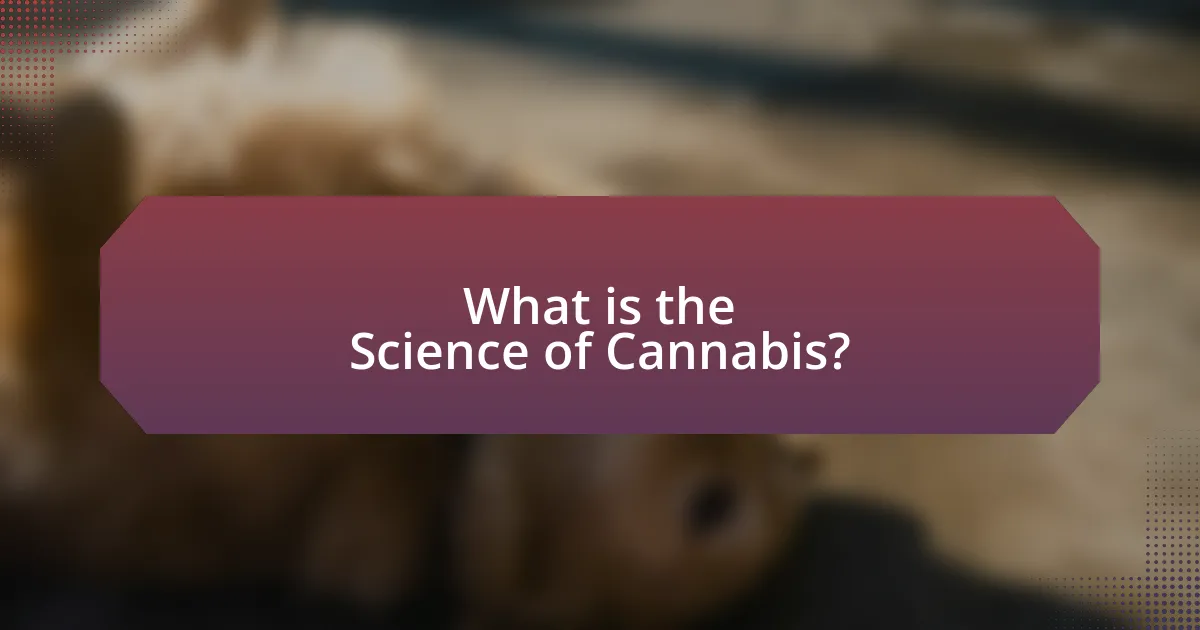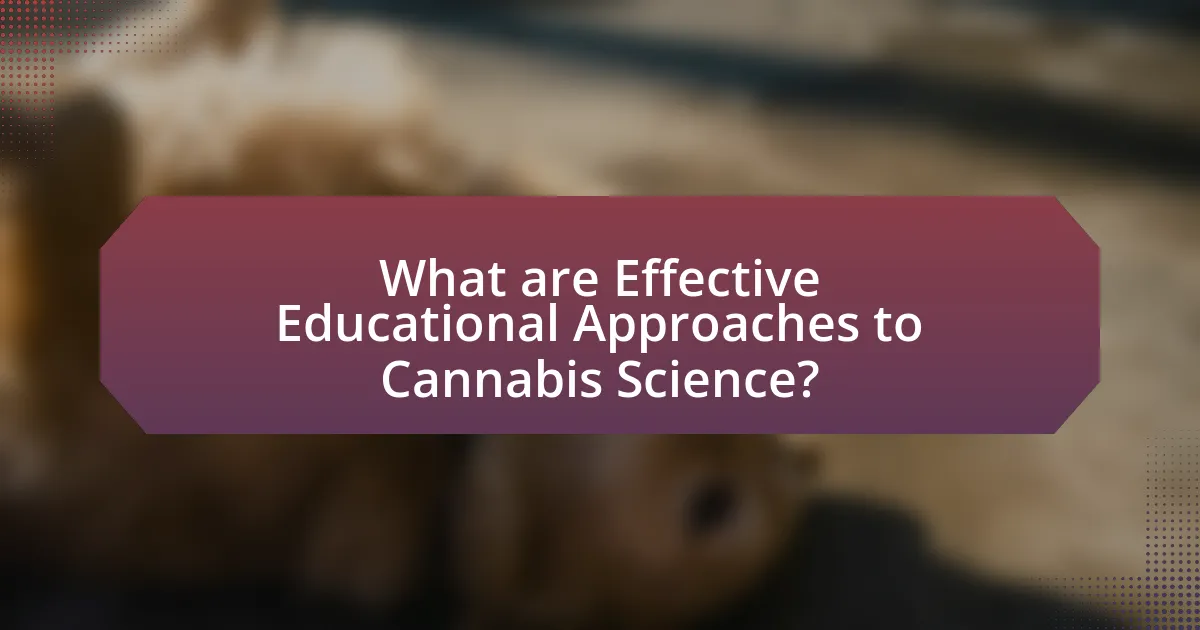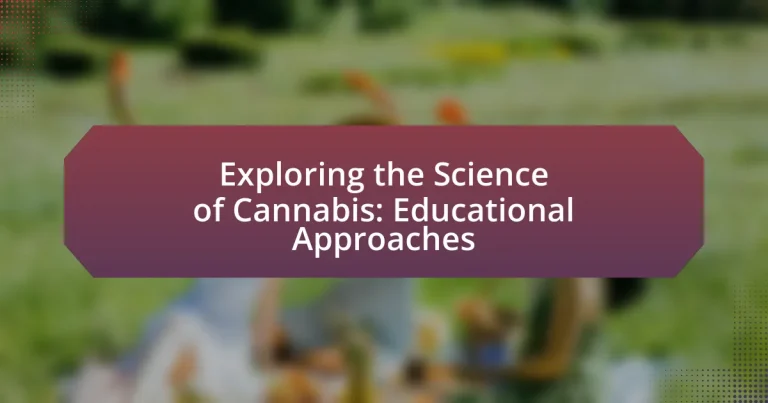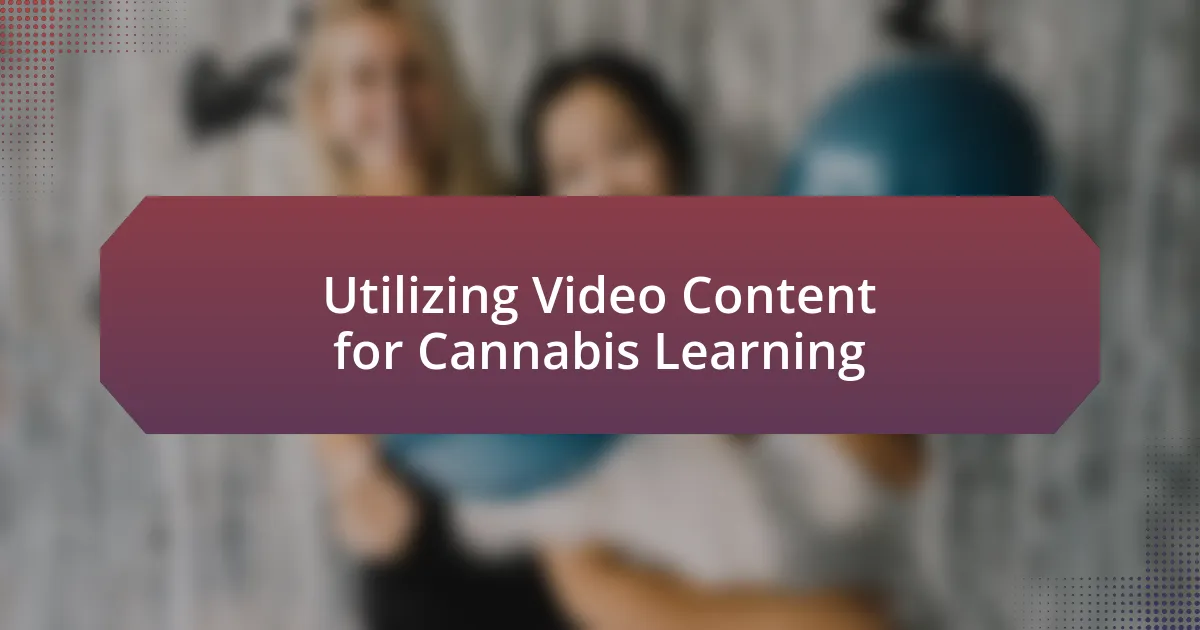The article focuses on the science of cannabis, specifically examining the plant Cannabis sativa, its chemical compounds, and their interactions with the human body. It discusses key cannabinoids like THC and CBD, their effects on the endocannabinoid system, and the therapeutic potential of cannabis for various medical conditions. Additionally, the article categorizes different cannabis strains—sativa, indica, and hybrid—highlighting their distinct effects and the importance of education in dispelling misconceptions about cannabis use. It emphasizes effective educational approaches, resources available for cannabis education, and the role of universities and community programs in enhancing public understanding of cannabis science.

What is the Science of Cannabis?
The science of cannabis encompasses the study of the plant Cannabis sativa, its chemical compounds, and their effects on human physiology. This field includes research on cannabinoids, such as THC and CBD, which interact with the endocannabinoid system in the body, influencing various physiological processes. Studies have shown that cannabinoids can affect pain perception, mood, and appetite, with clinical research indicating potential therapeutic applications for conditions like chronic pain and epilepsy. For instance, a study published in the Journal of Pain Research found that cannabis can significantly reduce chronic pain in patients, highlighting its medicinal properties.
How does cannabis interact with the human body?
Cannabis interacts with the human body primarily through the endocannabinoid system (ECS), which consists of cannabinoid receptors, endocannabinoids, and enzymes. The two main types of receptors, CB1 and CB2, are activated by cannabinoids such as THC and CBD found in cannabis. Activation of CB1 receptors, predominantly located in the brain, influences mood, memory, and pain perception, while CB2 receptors, found mainly in the immune system, modulate inflammation and immune responses. Research indicates that THC can produce psychoactive effects by mimicking the action of naturally occurring endocannabinoids, leading to alterations in sensory perception and cognitive function. Additionally, studies have shown that CBD may counteract some of THC’s effects and has potential therapeutic benefits, such as reducing anxiety and inflammation.
What are the key compounds found in cannabis?
The key compounds found in cannabis are cannabinoids, terpenes, and flavonoids. Cannabinoids, such as tetrahydrocannabinol (THC) and cannabidiol (CBD), interact with the body’s endocannabinoid system, influencing various physiological processes. Terpenes, which are aromatic compounds, contribute to the plant’s scent and may have therapeutic effects; for example, myrcene is known for its sedative properties. Flavonoids, which provide color to the plant, also possess antioxidant and anti-inflammatory properties. Research indicates that these compounds work synergistically, enhancing the overall effects of cannabis, a phenomenon known as the “entourage effect.”
How do cannabinoids affect the endocannabinoid system?
Cannabinoids interact with the endocannabinoid system by binding to cannabinoid receptors, primarily CB1 and CB2, which are distributed throughout the body. This interaction modulates various physiological processes, including pain sensation, mood regulation, and immune response. Research indicates that THC, a well-known cannabinoid, activates CB1 receptors in the brain, leading to psychoactive effects, while CBD, another prominent cannabinoid, has a more complex interaction, often inhibiting the effects of THC and promoting homeostasis. Studies, such as those published in the Journal of Pharmacology and Experimental Therapeutics, demonstrate that cannabinoids can influence neurotransmitter release and cellular signaling pathways, thereby affecting overall health and wellness.
What are the different types of cannabis?
The different types of cannabis are primarily categorized into three main strains: Cannabis sativa, Cannabis indica, and Cannabis ruderalis. Cannabis sativa is known for its uplifting effects and is often associated with increased energy and creativity. Cannabis indica, on the other hand, is recognized for its relaxing and sedative properties, making it suitable for stress relief and sleep aid. Cannabis ruderalis is less common and typically has lower THC levels; it is often used in breeding for its autoflowering characteristics. These classifications are supported by botanical taxonomy and the varying chemical profiles of cannabinoids and terpenes found in each strain.
What distinguishes indica, sativa, and hybrid strains?
Indica, sativa, and hybrid strains are distinguished primarily by their genetic lineage and effects on the user. Indica strains, derived from Cannabis indica, typically produce relaxing effects, making them suitable for nighttime use and alleviating anxiety or insomnia. Sativa strains, originating from Cannabis sativa, are known for their uplifting and energizing effects, often enhancing creativity and focus, making them more suitable for daytime use. Hybrid strains are a combination of both indica and sativa genetics, allowing for a wide range of effects depending on the specific balance of the two parent strains. This classification is supported by the varying cannabinoid and terpene profiles found in each strain type, which influence their unique effects and therapeutic benefits.
How do different strains affect users differently?
Different cannabis strains affect users differently primarily due to their unique chemical profiles, including varying levels of cannabinoids and terpenes. For instance, strains high in THC typically produce psychoactive effects, leading to euphoria or increased appetite, while strains with higher CBD content may offer therapeutic benefits without significant intoxication. Research indicates that terpenes, such as myrcene and limonene, also play a crucial role in modulating effects, influencing mood and relaxation levels. A study published in the Journal of Cannabis Research found that users reported distinct experiences based on strain selection, highlighting the importance of understanding strain-specific effects for tailored therapeutic use.

Why is Education on Cannabis Important?
Education on cannabis is important because it equips individuals with accurate information regarding its effects, benefits, and risks. Understanding cannabis can lead to informed decision-making, particularly as legalization spreads; for instance, a 2021 study published in the Journal of Cannabis Research found that education significantly reduces misconceptions about cannabis use and its health implications. Furthermore, education fosters responsible usage, which is crucial for public health and safety, as evidenced by data from the National Institute on Drug Abuse indicating that informed users are less likely to misuse cannabis.
What are the common misconceptions about cannabis?
Common misconceptions about cannabis include the belief that it is entirely harmless, that it leads to the use of harder drugs, and that it has no medicinal value. Many people think cannabis is completely safe due to its natural origin, but studies show that it can impair cognitive function and lead to addiction in some users, with approximately 9% of users developing a dependency (National Institute on Drug Abuse). Additionally, the notion that cannabis use inevitably leads to the use of more dangerous substances is based on the “gateway drug” theory, which lacks conclusive evidence; research indicates that social and environmental factors play a more significant role in substance use patterns. Lastly, the misconception that cannabis lacks therapeutic benefits is contradicted by numerous studies, including those published in the Journal of the American Medical Association, which highlight its effectiveness in treating conditions such as chronic pain, epilepsy, and multiple sclerosis.
How can education help dispel myths surrounding cannabis use?
Education can dispel myths surrounding cannabis use by providing accurate information based on scientific research and evidence. For instance, educational programs that focus on the pharmacology of cannabis can clarify misconceptions about its effects, such as the difference between THC and CBD, and their respective impacts on health. Research from the National Academies of Sciences, Engineering, and Medicine indicates that cannabis can be effective for certain medical conditions, which counters the myth that it has no therapeutic value. Furthermore, comprehensive education can address the social and legal implications of cannabis use, helping to dismantle stereotypes and promote informed decision-making among individuals.
What role does stigma play in cannabis education?
Stigma significantly hinders cannabis education by perpetuating misinformation and limiting open discussions about its benefits and risks. This negative perception often leads to a lack of credible information being disseminated, which can result in misconceptions about cannabis use and its effects. Research indicates that stigma can deter individuals from seeking knowledge or engaging in conversations about cannabis, thereby reinforcing existing biases and preventing informed decision-making. For instance, a study published in the Journal of Psychoactive Drugs found that stigma surrounding cannabis use is associated with lower levels of knowledge and understanding among the public, highlighting the detrimental impact of stigma on effective cannabis education.
How can educational approaches improve public understanding of cannabis?
Educational approaches can improve public understanding of cannabis by providing accurate, evidence-based information that addresses misconceptions and promotes informed decision-making. For instance, comprehensive educational programs can clarify the differences between medical and recreational cannabis, explain the effects of cannabinoids, and highlight the legal implications of cannabis use. Research indicates that states with robust cannabis education initiatives report lower rates of misuse among youth, demonstrating the effectiveness of informed education in shaping public perception and behavior.
What methods are most effective for teaching about cannabis science?
The most effective methods for teaching about cannabis science include experiential learning, interactive workshops, and evidence-based curriculum development. Experiential learning allows students to engage directly with cannabis plants and products, enhancing their understanding through hands-on experience. Interactive workshops facilitate discussions and practical applications of cannabis science, promoting critical thinking and collaboration among learners. Evidence-based curriculum development ensures that the content is grounded in the latest scientific research, providing accurate and relevant information. For instance, studies have shown that students retain information better when they participate in active learning environments, which supports the effectiveness of these methods in cannabis education.
How can community programs enhance cannabis education?
Community programs can enhance cannabis education by providing accessible, localized information and resources tailored to specific community needs. These programs often include workshops, seminars, and informational sessions led by experts, which facilitate direct engagement and foster a deeper understanding of cannabis science, usage, and regulations. For instance, a study by the National Institute on Drug Abuse highlights that community-based education initiatives can significantly improve knowledge and attitudes towards cannabis, leading to informed decision-making among participants. By addressing misconceptions and promoting evidence-based information, community programs play a crucial role in enhancing public awareness and understanding of cannabis.

What are Effective Educational Approaches to Cannabis Science?
Effective educational approaches to cannabis science include experiential learning, interdisciplinary curricula, and evidence-based research. Experiential learning, such as hands-on laboratory work and field studies, allows students to engage directly with cannabis cultivation and analysis, enhancing their understanding of plant biology and chemistry. Interdisciplinary curricula that integrate biology, chemistry, pharmacology, and social sciences provide a comprehensive view of cannabis, addressing its medical, legal, and societal implications. Evidence-based research, including peer-reviewed studies, ensures that educational content is grounded in scientifically validated information, fostering critical thinking and informed discussions among students. For instance, the National Institute on Drug Abuse provides extensive research on cannabis effects, which can be utilized in educational settings to support evidence-based learning.
What resources are available for cannabis education?
Various resources are available for cannabis education, including online courses, academic research papers, and community workshops. Online platforms like Leafly and NORML provide comprehensive guides and articles on cannabis science, legislation, and usage. Academic institutions, such as the University of California, offer specialized courses in cannabis studies, focusing on its biology, chemistry, and societal impacts. Additionally, organizations like the Cannabis Training University and the American Cannabis Nurses Association provide certifications and training programs for professionals. These resources collectively enhance understanding and knowledge about cannabis, supported by a growing body of research and educational initiatives.
How can online platforms facilitate cannabis learning?
Online platforms can facilitate cannabis learning by providing accessible educational resources, interactive courses, and community engagement opportunities. These platforms often host a variety of content, including articles, videos, and webinars that cover scientific research, cultivation techniques, and medicinal uses of cannabis. For instance, platforms like Leafly and NORML offer comprehensive guides and expert insights, making it easier for users to understand complex topics. Additionally, online forums and social media groups enable learners to connect with experts and peers, fostering discussions that enhance knowledge retention and practical application.
What role do universities play in cannabis research and education?
Universities play a crucial role in cannabis research and education by conducting scientific studies, developing curricula, and providing training for future professionals in the field. They facilitate research initiatives that explore the medical, agricultural, and social aspects of cannabis, contributing to a growing body of knowledge. For instance, institutions like the University of California, Davis, and Colorado State University have established programs dedicated to cannabis science, focusing on areas such as plant biology, pharmacology, and policy analysis. These programs not only advance academic understanding but also prepare students for careers in the evolving cannabis industry, reflecting the increasing acceptance and legalization of cannabis across various regions.
How can educators assess the effectiveness of cannabis education?
Educators can assess the effectiveness of cannabis education by utilizing pre- and post-assessment surveys to measure changes in knowledge, attitudes, and behaviors regarding cannabis use. These assessments can include multiple-choice questions, true/false statements, and open-ended responses that gauge students’ understanding of cannabis-related topics. Research indicates that structured educational programs can lead to significant increases in knowledge; for example, a study published in the Journal of Drug Education found that participants who underwent a cannabis education program showed a 40% increase in knowledge retention compared to those who did not receive the education. Additionally, educators can analyze behavioral changes through follow-up surveys or interviews to determine if students apply what they learned in real-life situations, further validating the program’s effectiveness.
What metrics can be used to evaluate learning outcomes in cannabis education?
Metrics that can be used to evaluate learning outcomes in cannabis education include knowledge assessments, skill demonstrations, and participant feedback. Knowledge assessments, such as quizzes and exams, measure the retention of information regarding cannabis science, legislation, and health effects. Skill demonstrations, which may involve practical applications like cultivation techniques or product analysis, assess the ability to apply learned concepts in real-world scenarios. Participant feedback, gathered through surveys or interviews, provides insights into the perceived effectiveness of the educational program and areas for improvement. These metrics collectively ensure a comprehensive evaluation of the educational impact on learners.
How can feedback from students improve cannabis educational programs?
Feedback from students can significantly enhance cannabis educational programs by identifying gaps in knowledge and areas for improvement. When students provide insights on course content, teaching methods, and resource materials, educators can tailor the curriculum to better meet learners’ needs. For instance, a study published in the Journal of Cannabis Research found that student evaluations led to curriculum adjustments that improved engagement and comprehension in cannabis-related courses. By systematically collecting and analyzing student feedback, educational institutions can create more effective and relevant programs that align with industry standards and student expectations.
What are best practices for teaching cannabis science?
Best practices for teaching cannabis science include integrating evidence-based research, utilizing hands-on learning experiences, and fostering an open dialogue about cannabis-related topics. Evidence-based research, such as studies published in journals like the Journal of Cannabis Research, provides a solid foundation for understanding the biological, chemical, and therapeutic aspects of cannabis. Hands-on learning experiences, such as laboratory experiments or field trips to cultivation sites, enhance student engagement and comprehension. Additionally, fostering an open dialogue encourages critical thinking and allows students to explore diverse perspectives on cannabis, which is essential given its complex legal and social implications.
How can educators create an inclusive learning environment for cannabis education?
Educators can create an inclusive learning environment for cannabis education by implementing diverse teaching strategies that accommodate various learning styles and backgrounds. This includes using a variety of instructional materials, such as visual aids, interactive activities, and real-life case studies, to engage students with different preferences. Additionally, fostering open discussions and creating a safe space for students to express their thoughts and experiences related to cannabis can enhance inclusivity. Research indicates that inclusive educational practices improve student engagement and learning outcomes, as seen in studies like “The Impact of Inclusive Teaching on Student Engagement” published in the Journal of Educational Psychology.
What strategies can be employed to engage diverse audiences in cannabis science?
To engage diverse audiences in cannabis science, employing inclusive educational strategies is essential. These strategies include utilizing culturally relevant materials, offering multilingual resources, and incorporating community-based participatory research. For instance, research shows that culturally tailored educational programs significantly improve knowledge retention and engagement among minority groups (Bennett et al., 2020, Journal of Cannabis Research). Additionally, interactive workshops and hands-on demonstrations can enhance understanding and interest, as they allow participants to experience cannabis science in a practical context. By addressing the specific needs and backgrounds of various audience segments, these strategies foster a more inclusive and effective learning environment in cannabis science.





